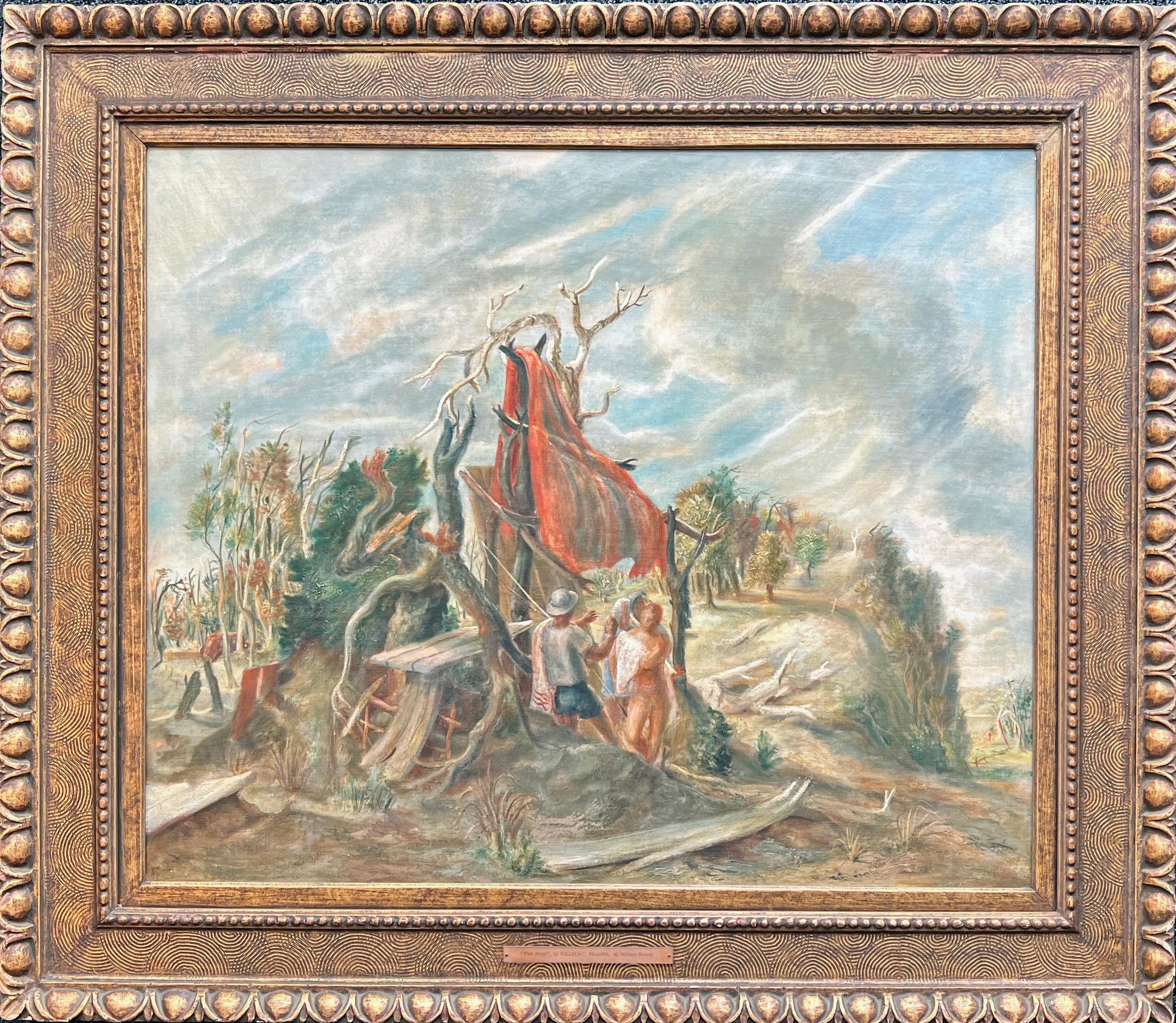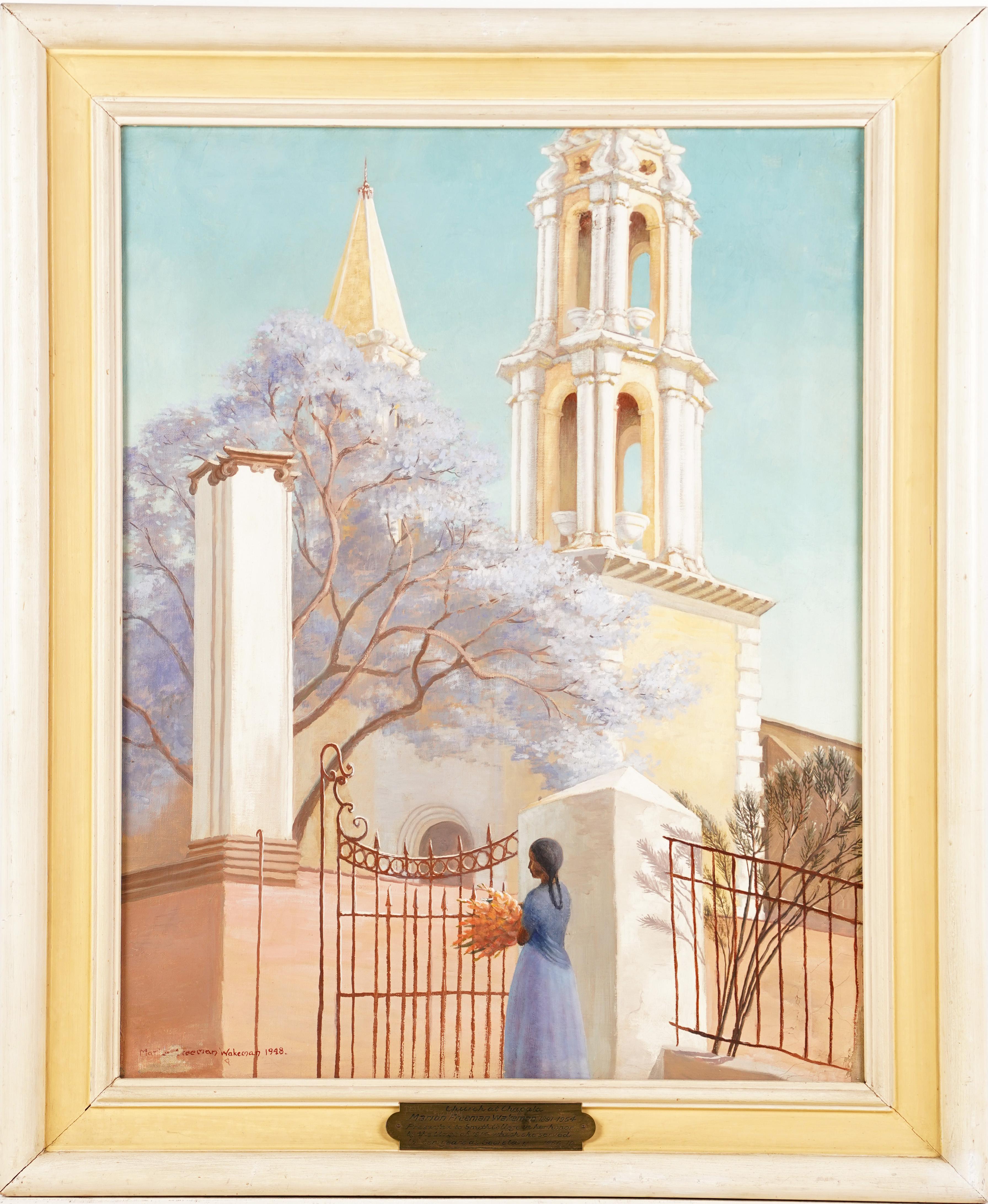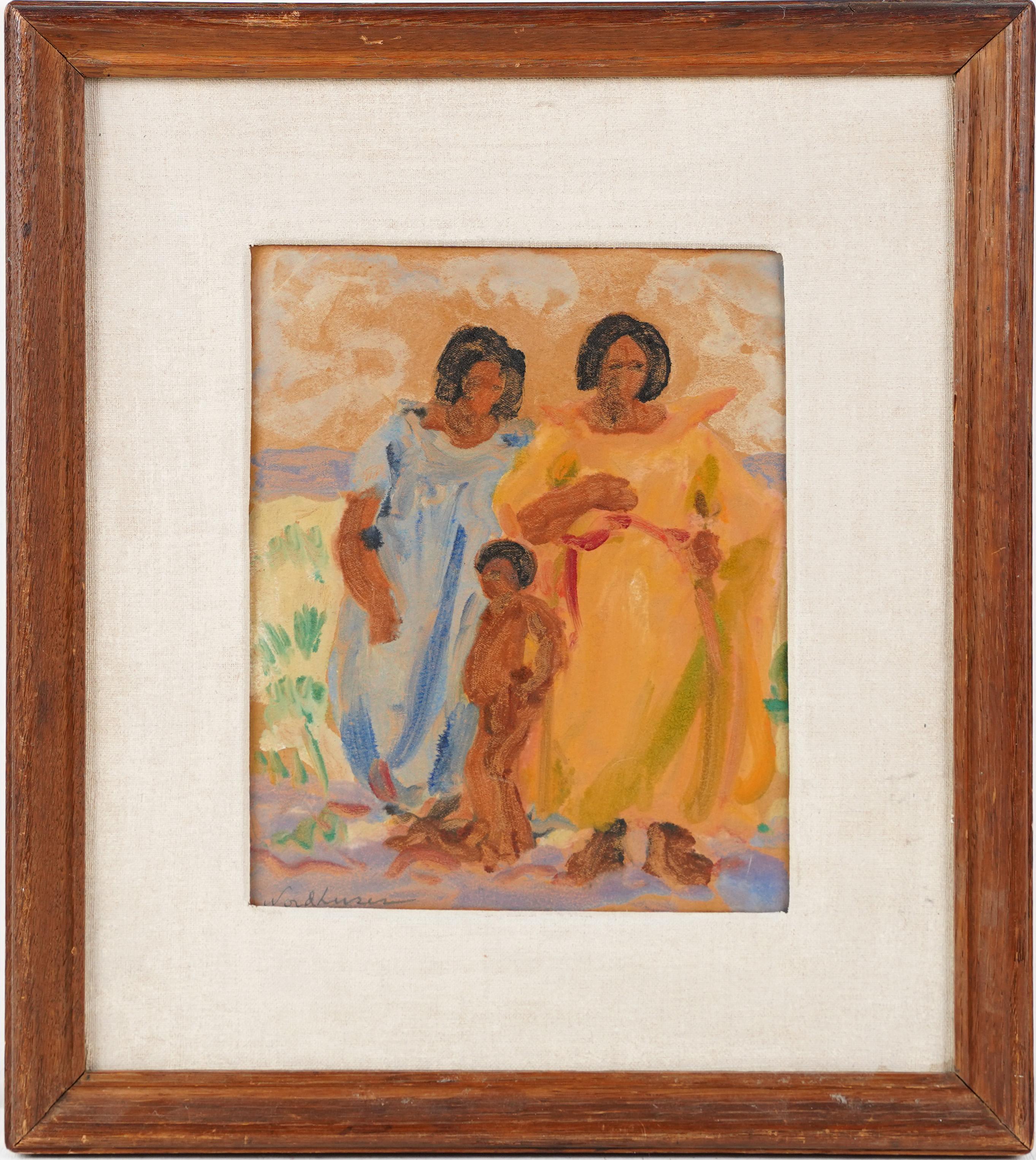Items Similar to On the Beach modernist oil painting by Byron Browne
Want more images or videos?
Request additional images or videos from the seller
1 of 8
Byron BrowneOn the Beach modernist oil painting by Byron Browne1959
1959
About the Item
Byron Browne
On the Beach (1959)
Oil on canvas, 20" x 26"
26" x 32" x 1" frame size - likely original
Inscribed verso "On the Beach / 1959 / Byron Browne"
Provenance: Private collection, Berkley, California
About this artist: Through an oeuvre displaying the re-envisioning of figural subjects and the formation of an abstract expressionist style, Byron Browne stands out among the American abstractionists of his generation. Born in Yonkers, New York, in 1907, the artist was a bright talent at the National Academy of Design in his teens. From 1924 to 1928 Browne studied at the Academy under notable artists Robert Aitkin, Charles Courtney Curran, Charles Hawthorne, Alice Murphy, and Ivan Olinsky. Despite the accolades for his academic style, towards the end of his education Browne began to gravitate towards abstraction. Together with friend Arshile Gorky, he observed the modernist advancements of Picasso, Georges Braque, and Joan Miró at Albert Gallatin’s Gallery of Living Art. Browne furthered his studies in modernism through the French periodical Cahiers d’Art, and in 1935 studied with abstract expressionist Hans Hofmann. His earlier representational art destroyed, Browne began holding solo exhibitions of his avant-garde work in 1933. Only two years later the first exhibition of his work with the Whitney Museum of American Art occurred at the 1935 “Abstract Painting in America” show, which featured Balcomb Greene, Arshile Gorky, and Stuart Davis. During the 1930s Browne found employment in the New Deal’s Federal Works of Art Project. After brief enrollment in the Easel division he entered the Mural division, designing murals for the United States Passport Office in Rockefeller Center, the radio station WNYC, and the Science and Health Building at the 1939 World’s Fair in New York. Together with Stuart Davis, Arshile Gorky, Karl Knaths, Willem de Kooning, Louis Schanker, and John Von Wicht, his works became definitive in the conception of abstract mural painting in America.
Committed to the development and promotion of America’s avant-gardes, Browne banded with fellow New York modern artists to form the American Abstract Artists group in 1936. Beyond the group’s successful exhibitions, Browne took a principal role in advocating the AAA’s positions. He participated in the 1940 picketing admonishing the Museum of Modern Art’s neglect of American modernists, and was one of six AAA members to sign a letter to the editor of Art Front responding to the narrow views on abstraction proposed by Baroness Hilla Rebay of the Solomon R. Guggenheim Foundation. During New York’s World’s Fair of 1939 Browne exhibited in the “Abstract Painting in America” show held in The Contemporary Art Pavilion among AAA founders Giorgio Cavallon, Balcomb Greene, Carl Holty, George L.K. Morris, and George McNeil. In 1940 Browne became a founding member of the Federation of Modern Painters and Sculptors, Inc., with Ilya Bolotwosky, Adolph Gottlieb, Balcomb Greene, and Mark Rothko. The artists, all members of the American Artists’ Congress, formed the Federation with a newfound commitment to aesthetic concerns as the Artists’ Congress found itself embedded in political controversy. The establishment of the Federation marked a new commitment to working towards the diversification and exhibition of nonacademic American art.
After marrying fellow abstract artist and AAA member Rosalind Bengelsdorf in 1940, Browne spent several years working as a guard in the Greek and Roman section of the Metropolitan Museum of Art. Classicist interests were later developed in Browne’s treatment of the human figure. He also took influence from Catalonian murals, and pre-Columbian, Assyrian, Chaldean, and Sumerian primitive styles. In his exploration of the depiction of figural scenes Browne collected a wide range of styles, combining ancient motifs with the techniques of modernism. Having begun his venture into abstraction through cubist fragmentation and the constructivist composition of geometric planes, Browne later branched out into biomorphism, his gestural style influencing the abstract expressionism of Jackson Pollock, Arshile Gorsky, and Willem de Kooning. His position on the connection between artistic form and nature, however, made him unique among the many artists seeking to separate nonfigurative art from figurative and declaring their works to be non-objective. As Browne drew attention to the transfer of three-dimensional objects to two-dimensional planes using bright shades of blocked color and the stylized treatment of his figural subjects, he explored his interest in the relationship between art and nature.
Towards the end of his life Browne became active in the artists’ colony of Provincetown, Massachusetts. He spent over a decade teaching at the Art Students League, and also held a position as a professor of advanced painting at New York University. On December 25, 1961, Browne died in New York at the age of fifty-four. Through his distinct interest in the act of representation within the modernist discourse, Browne re-conceptualized figural art for the twentieth century. His approach to the human figure and the advancements of his stylistic techniques left a striking impression on the abstract art movement in America.
Zenobia Grant Wingate
- Creator:Byron Browne (1907-1961, American)
- Creation Year:1959
- Dimensions:Height: 20 in (50.8 cm)Width: 26 in (66.04 cm)
- Medium:
- Movement & Style:
- Period:
- Condition:
- Gallery Location:Hudson, NY
- Reference Number:
About the Seller
5.0
Vetted Seller
These experienced sellers undergo a comprehensive evaluation by our team of in-house experts.
Established in 1973
1stDibs seller since 2023
5 sales on 1stDibs
Typical response time: <1 hour
- ShippingRetrieving quote...Ships From: Hudson, NY
- Return PolicyThis item cannot be returned.
More From This SellerView All
- Fish Story oil painting by Williams Charles PalmerLocated in Hudson, NYThis painting is illustrated in the Catalogue of the 1945 Encyclopedia Britannica Collection of Contemporary American Painting, p.84. Written and edited by Grace Pagano. "Painting ...Category
Mid-20th Century American Modern Figurative Paintings
MaterialsOil, Canvas
- The Junkman's Serenade oil painting by Gregorio PrestopinoBy Gregorio PrestopinoLocated in Hudson, NYThis work epitomizes Prestopino's interest in social realism which captures a quiet interlude in the everyday life of an "everyman." It also provides a contrast for our expectations as we view a tough, blue collar worker, with no one watching, as he sings a melody to the birds. In an original frame measuring 49" x 39" x 3.25" Provenance: Edith Halpert's Downtown Gallery (label verso from 13 w. 113th street, where the gallery was located from 1926 until 1939) Private collection, NYC, c. 1935 By descent About this artist: Born in Little Italy in 1907, Gregorio Prestopino first set out to become a sign painter as the son of New York City immigrants. Instead, his talent provided a life-changing scholarship to the National Academy of Design, and for five years he studied drawing under C. W. Hawthorne. He spent the summer of 1934 at the MacDowell Colony in Peterborough, New Hampshire. His deep involvement with the colony led him to later serve as its director in 1954. Much of Prestopino’s work was in the vein of social realism. During the 1940s and 1950s he became deeply invested in portraying everyday Manhattan and Harlem scenes. He first became interested in the Ashcan school at the National Academy of Design, and remained committed to an interest in working with urban scenes. His lively treatment of people and events revealed his affinity for sixteenth-century artist Pieter Breughel...Category
Early 20th Century Modern Figurative Paintings
MaterialsOil, Canvas
- Pleasant Thoughts oil painting by Arthur Fitzwilliam TaitBy Arthur Fitzwilliam TaitLocated in Hudson, NYThis painting is listed in the W.H. Cadbury and H.F. Marsh book Arthur Fitzwilliam Tait: Artist in the Adirondacks, Newark, Delaware, 1986, no.59.36t. It is hand-signed "AF Tait...Category
1850s Hudson River School Figurative Paintings
MaterialsOil, Canvas
- The Beekeeper's Daughter oil painting by Henry BaconBy Henry BaconLocated in Hudson, NYSigned and dated "Henry Bacon 1881" lower right. Provenance: private collection About this artist: A figure painter in the conservative tradition of the late 19th century French, H...Category
1880s Hudson River School Figurative Paintings
MaterialsOil, Canvas
- The Lonely Road by William Charles PalmerLocated in Hudson, NYThe Lonely Road (1940) Tempera on panel 12" x 16" 19 1/2" x 23 1/2" x 1 1/2" framed Hand-signed "Palmer '40" lower center. Provenance: Midtown Galleries, New York, NY (labels verso...Category
Mid-20th Century American Modern Figurative Paintings
MaterialsPanel, Tempera
- Vienna Flower Market oil painting by Emil BarbariniLocated in Hudson, NYPainting measures 10 ½" x 16" and framed 20 ½" x 26" x 4"Category
1920s Impressionist Landscape Paintings
MaterialsPanel, Oil
You May Also Like
- Six O'ClockLocated in Los Angeles, CASix O-Clock, c. 1942, oil on canvas, 30 x 20 inches, signed and titled several times verso of frame and stretcher (perhaps by another hand), marked “Rehn” several times on frame (for the Frank K. M. Rehn Galleries in New York City, who represented Craig at the time); Exhibited: 1) 18th Biennial Exhibition of Contemporary American Oil Paintings from March 21 to May 2, 1943 at The Corcoran Gallery of Art in Washington, D.C. #87, original price $450 (per catalog) (exhibition label verso), 2) Craig’s one-man show at the Frank K. M. Rehn Galleries, New York City, from October 26 to November 14, 1942, #10 (original price listed as $350); and 3) Exhibition of thirty paintings sponsored by the Harrisburg Art Association at the State Museum of Pennsylvania in Harrisburg in March, 1944 (concerning this exhibit, Penelope Redd of The Evening News (Harrisburg, Pennsylvania) wrote: “Other paintings that have overtones of superrealism inherent in the subjects include Tom Craig’s California nocturne, ‘Six O’Clock,’ two figures moving through the twilight . . . .” March 6, 1944, p. 13); another label verso from The Museum of Art of Toledo (Ohio): original frame: Provenance includes George Stern Gallery, Los Angeles, CA About the Painting Long before Chris Burden’s iconic installation outside of the Los Angeles County Museum of Art, Urban Light, another artist, Tom Craig, made Southern California streetlights the subject of one of his early 1940s paintings. Consisting of dozens of recycled streetlights from the 1920s and 1930s forming a classical colonnade at the museum’s entrance, Burden’s Urban Light has become a symbol of Los Angeles. For Burden, the streetlights represent what constitutes an advanced society, something “safe after dark and beautiful to behold.” It seems that Craig is playing on the same theme in Six O-Clock. Although we see two hunched figures trudging along the sidewalk at the end of a long day, the real stars of this painting are the streetlights which brighten the twilight and silhouette another iconic symbol of Los Angeles, the palm trees in the distance. Mountains in the background and the distant view of a suburban neighborhood join the streetlights and palm trees as classic subject matter for a California Scene painting, but Craig gives us a twist by depicting the scene not as a sun-drenched natural expanse. Rather, Craig uses thin layers of oil paint, mimicking the watercolor technique for which he is most famous, to show us the twinkling beauty of manmade light and the safety it affords. Although Southern California is a land of natural wonders, the interventions of humanity are already everywhere in Los Angeles and as one critic noted, the resulting painting has an air of “superrealism.” About the Artist Thomas Theodore Craig was a well-known fixture in the Southern California art scene. He was born in Upland California. Craig graduated with a degree in botany from Pomona College and studied painting at Pamona and the Chouinard Art School with Stanton MacDonald-Wright and Barse Miller among others. He became close friends with fellow artist Milford Zornes...Category
1940s American Modern Landscape Paintings
MaterialsCanvas, Oil
- Mid-Century Oil on Canvas. Harbour scene. Farewell to the Fishermen.Located in Cotignac, FRMid 20th century oil on canvas of a crowded harbour scene, showing the local fisherman or sailors saying farewell to their families before going to sea. The painting is signed bottom right but the artist remains as yet unidentified. A colourful yet slightly brooding and dreamlike painting. The figures are faceless and the shapes loose and undefined reminiscent of the works by Balthus who in turn was influenced by LS Lowry and his scenes of industrial districts. The colours are deep and glowing and the shapes of the figures are rounded giving a sense of warmth and evoking the quality of light seen at either dawn or dusk. Balthasar Klossowski de Rola (February 29, 1908 – February 18, 2001), known as Balthus, was a Polish-French modern artist. He is known for his erotically charged images of pubescent girls, but also for the refined, dreamlike quality of his imagery. Lowry is famous for painting scenes of life in the industrial districts of North West England in the mid-20th century. He developed a distinctive style of painting and is best known for his urban landscapes peopled with human figures often referred to as "matchstick men".Category
Mid-20th Century Modern Figurative Paintings
MaterialsCanvas, Oil
- La Madeleine, Paris Street SceneLocated in Cotignac, FRMid 20th Century oil on canvas painting of a Paris street scene with the columns of La Madeleine in the distance, signed Deuvray bottom left. The canvas is on its original stretcher ...Category
1950s Modern Landscape Paintings
MaterialsCanvas, Oil
- Church at Chapala Signed Marion Wakeman Taos School Exhibited Oil PaintingLocated in Buffalo, NYAntique American modernist landscape painting by Marion D Freeman Wakeman (1891 - 1953). Oil on canvas. Framed. Signed. Image size, 26H x 20LCategory
1940s Modern Landscape Paintings
MaterialsCanvas, Oil
- Antique American School Modernist Landscape Signed Western Oil on PaperLocated in Buffalo, NYSigned illegibly lower left. Oil on paper. 10 x 8.Category
1920s Modern Landscape Paintings
MaterialsCanvas, Oil
- CityscapeBy Enid SmileyLocated in Buffalo, NYAn original oil on canvas painting by American female artist Enid Smiley. Enid Smiley (1924-2004) American New York. Born as Enid Ginsberg and later the family name changed to Gilb...Category
1970s Modern Figurative Paintings
MaterialsCanvas, Oil
Recently Viewed
View AllMore Ways To Browse
Paintings Of French Beaches
Robert L Davis Oil
Obiora Anamaleze
Arthur Kerns
Salon De Provence
Palestinian Dress
Allegory Of Spring
Russian Woman Portrait Painting
Swedish Figure Painting
Value Of A Wooden Gun Box
Dtr Modern Clarence James
Hamptons Beach Painting
Arnold Circus
Emile Avon
Marine Corps Hat
Mary Jo McGonagle On Sale
Marz Junior
Masonite Ring





